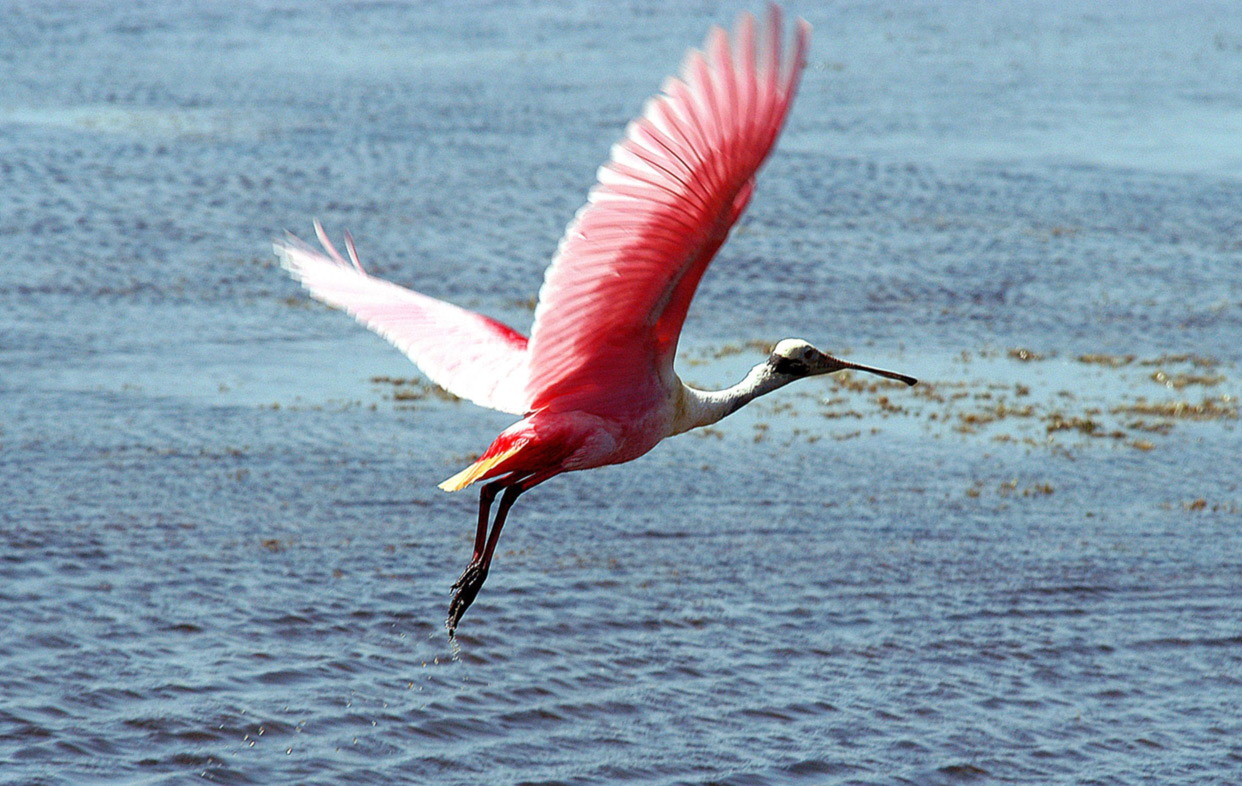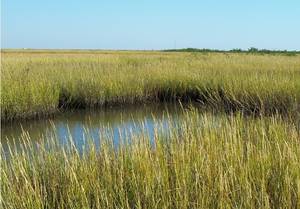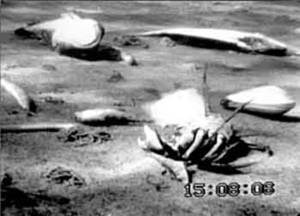Gulf of Mexico spill and the Louisiana wetlands
Interview with
The issue of oil spills and the environmental problems they can unleash have barely left the news headlines over the past few months with events unfolding in the Gulf of Mexico, following the explosion on the Deepwater Horizon oil rig. As well as the potential impacts on marine birds, turtles, dolphins, and so on, there's a lot less obvious marine life that can also get hit hard with some really worrying consequences. To tell us more about the hidden side of oil spills, I spoke to Robinson Fulweiler from Boston University in the US...
Robinson - They're not as clean and pristine looking from the outside eye as something like a coral reef that you might go snorkelling on, but marshes and mangroves are full of amazing creatures. They are home to things like barnacles and sponges, fish and crabs, even muskrats and, of course, millions and millions of birds. In Louisiana, one of my favourite birds is the Roseate Spoonbill and this bird has a pale yellow head and then this beautiful white neck and the rest of it is all kind of hot pink.  Beyond all of the visual things that we may like to see, [the wetlands] have a lot of things that are important that we probably don't notice offhand. They're a primary nursery habitat for lots of important fish species, both commercial, so things we like to eat and sell, and then they provide the homes for a lot of the base of the food web. And then they are important for things that we called 'ecosystem values' and these are much harder to quantify. So they do things like help us with flood mitigation; you can think of a wetland like a giant sponge. When you have lots of water coming in, these wetlands can soak up that water and help us with floods. Then both wetlands and mangroves are really important for storm abatement and stopping storm surges, and waves coming in. Even things like tsunamis, mangroves really are good at slowing down those kind of waves. I think that the thing that I'm probably most interested in is the idea of wetlands and mangroves being important for water quality. So, not only can you think of a wetland as a sponge, but you can kind of think of it as a giant filter too. There are lots of microbial processes that go on in wetlands that actually clean up our water.
Beyond all of the visual things that we may like to see, [the wetlands] have a lot of things that are important that we probably don't notice offhand. They're a primary nursery habitat for lots of important fish species, both commercial, so things we like to eat and sell, and then they provide the homes for a lot of the base of the food web. And then they are important for things that we called 'ecosystem values' and these are much harder to quantify. So they do things like help us with flood mitigation; you can think of a wetland like a giant sponge. When you have lots of water coming in, these wetlands can soak up that water and help us with floods. Then both wetlands and mangroves are really important for storm abatement and stopping storm surges, and waves coming in. Even things like tsunamis, mangroves really are good at slowing down those kind of waves. I think that the thing that I'm probably most interested in is the idea of wetlands and mangroves being important for water quality. So, not only can you think of a wetland as a sponge, but you can kind of think of it as a giant filter too. There are lots of microbial processes that go on in wetlands that actually clean up our water.
Helen - And in terms of that nutrient removal, how does that actually happen? Where do the nutrients go?
Robinson - You can think of it just like this: the water is flowing through the wetlands and it's bringing with it sediments and all these nutrients, and the sediment can get trapped in the plants themselves, in the leaves and the and the stalks. Then the nutrients can get taken up by the vegetation or by the microbial community that's living in those sediments. What they do there, the microbes use [the sediments] for energy, they're using them for food, and they convert them into their own biomass. So they actually can absorb these nutrients. One process that we are particularly interested in is something called 'denitrification.' In denitrification, there's a group of organisms that take nitrate which is NO3 and one of those nutrients that come in through fertilizer and waste water treatment.  So, they take this form of biologically usable nitrogen, and what I mean by that is plants can use it and the microbes can use it, and they turn it into N2 gas. By doing that, they're essentially taking it from this usable form to a gas that's basically unusable to the majority of organisms on the planet. So they've actually removed it from the system and since humans add lots of nitrogen to the natural system in terms of fertilizer, we need these microbes to kind of clean up our act if you will.
So, they take this form of biologically usable nitrogen, and what I mean by that is plants can use it and the microbes can use it, and they turn it into N2 gas. By doing that, they're essentially taking it from this usable form to a gas that's basically unusable to the majority of organisms on the planet. So they've actually removed it from the system and since humans add lots of nitrogen to the natural system in terms of fertilizer, we need these microbes to kind of clean up our act if you will.
Helen - And what do we know about how oil contamination might affect those microbes? Is it toxic to them?
Robinson - It's one of those things where we're probably not 100% sure. Most of the work that's been done on looking at the effect of oil on denitrification has been done in the '80s or early '90s. They found that, in most cases, the oil was toxic to them but they weren't able to separate completely if it was a direct effect of toxicity to the cell itself or if it was because it changed the environmental conditions in which they live, and then made the habitat not ideal for them. So for instance when this process takes place, it's often important to take the sediments and mix it up and what I mean by that is that things like crabs make burrows and they burrow down into the sediment. When they do that, they are bringing fresh organic matter down with them and they're exposing this layer to oxygen. And when you put a layer of oil on top of a salt marsh, typically, we find it that crabs no longer burrow the way they normally do. Sometimes they just die outright and other times they simply stop their burrowing. And when you do that, you're changing this environment that the microbes are living in.
Helen - So presumably, if we see wetlands losing their ability to mop up nutrients, we could also see some of the existing problems in the Gulf of Mexico like the Dead Zone, get much worse.
 Robinson - Exactly. I saw a couple of days ago that they reported that the Dead Zone this year was one of the largest that's ever been, about 20,000 square kilometres - that's equal to the size of Massachusetts where I currently live, the State of Massachusetts. That's a huge Dead Zone and that's absolutely true - the thought there is that the Mississippi used to flood every year and flow over to the banks and then it would allow the sediment and nutrients to go in to the marsh and the marsh could do its nutrient filtering thing that it does so well. Plus, we had a lot less nitrogen coming in at that point before we levied the Mississippi river. But now, we keep the river sort of on a pipe, all the way to the coast and we don't allow it to overflow into the marsh. We've cut off this natural filtering capacity. So, it's bad for the marsh because it needs nutrients and sediment to grow and we don't give it that anymore. And then it's bad for the coastal area in the Dead Zone because we're directly transporting this nutrient rich water from all of the farm belt in the US out into the Gulf of Mexico.
Robinson - Exactly. I saw a couple of days ago that they reported that the Dead Zone this year was one of the largest that's ever been, about 20,000 square kilometres - that's equal to the size of Massachusetts where I currently live, the State of Massachusetts. That's a huge Dead Zone and that's absolutely true - the thought there is that the Mississippi used to flood every year and flow over to the banks and then it would allow the sediment and nutrients to go in to the marsh and the marsh could do its nutrient filtering thing that it does so well. Plus, we had a lot less nitrogen coming in at that point before we levied the Mississippi river. But now, we keep the river sort of on a pipe, all the way to the coast and we don't allow it to overflow into the marsh. We've cut off this natural filtering capacity. So, it's bad for the marsh because it needs nutrients and sediment to grow and we don't give it that anymore. And then it's bad for the coastal area in the Dead Zone because we're directly transporting this nutrient rich water from all of the farm belt in the US out into the Gulf of Mexico.
Helen - Now we passed the 100-day mark after the Deepwater Horizon explosion and there was a lot of talk about how the spill was perhaps not such a terrible ecological disaster as we'd all feared initially. Do you think we should still be concerned about the impact of oil in the region?
Robinson - Absolutely. I think the first is that Louisiana's wetlands have been in trouble for a long time and the last thing that they needed was this oil spill. We lose an area of wetland about the size of a tennis court every 30 seconds or so in Louisiana. Because of how the system is set up, it's losing a lot of salt marsh to sea level rise. Plus, we've already gone in there and done things like we put a lot of piping for the oil and gas industry underneath the salt marsh so that's disrupted it. We've removed things like water and gas from underneath the salt marsh, underneath the wetlands, so they're actually sinking. And then we had things like hurricane Katrina that came in and really caused some serious damage. Plus, as I mentioned, this fact that we've disconnected the wetlands from the river and this natural process that helps build them. So the wetlands are already in big trouble down there and the last thing they certainly needed was this oil spill. I think that we all keep our fingers crossed that the oil spill is not a disaster and that it would go away, and wouldn't be a problem. But I think that it's much too early to say that. If we look at some of the work that the people have done on some of the big oil spills like the Exxon Valdez oil spill, a lot of the acute effect seems to go away relatively quickly. So, a lot of birds and mammals died and then we didn't see anything and so I think people tend to think it's okay, but there are issues with chronic low level exposure to oil. We could see that certainly in Louisiana and there's a recent report saying that some of the blue crab larvae actually had oil attached to them. And when larvae are exposed to hydrocarbons, they can actually have mutations and become deformed. A scientist I read in the newspaper the other day said that a deformed larvae is just as bad as a dead larvae. I think we definitely hope that it's not going to be as bad as we all imagined, but I think it's much too early to say that.
Helen - That's Robinson Fulweiler from Boston University, talking about the Louisiana wetlands and the crucial hidden world of microbes.
Find out more
Oil and oil spills: the Gulf of Mexico. Marine science review (papers from 30 years of oil spill studies). Sea Web (PDF) Robinson Fulweiler.
Assistant Professor, Department of Earth Sciences, Boston University










Comments
Add a comment